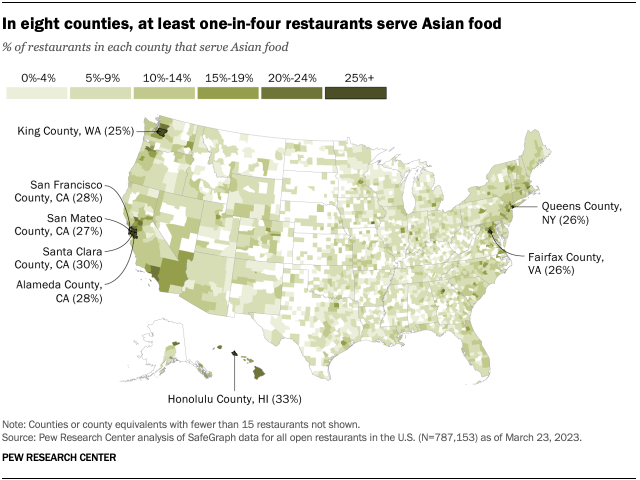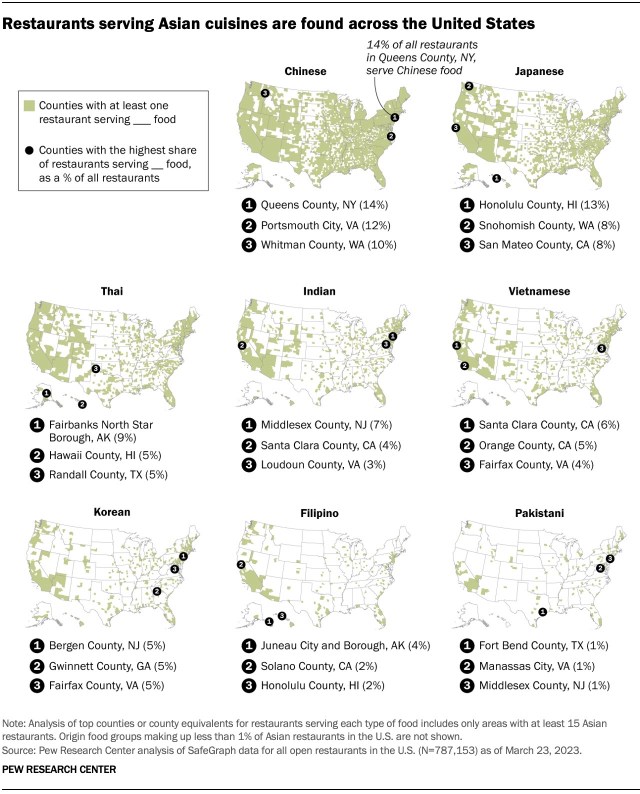Some 12% of all restaurants in the United States serve Asian food, according to a new Pew Research Center analysis. That share is slightly higher than the 7% of the U.S. population that is Asian American.
Around seven-in-ten of all Asian restaurants in the U.S. serve the food of just three Asian origin groups: Chinese, Japanese and Thai. These groups together comprise 33% of the U.S. Asian population.
Here are some other key takeaways from the analysis, which is based on data from SafeGraph, a data company that curates high-precision data on millions of places around the globe.
Chinese establishments are by far the most common type of Asian restaurant in the U.S. Nearly four-in-ten Asian restaurants (39%) serve Chinese food, which has a long history in the U.S. By comparison, Chinese Americans account for about a quarter of Asians living in the U.S. (24%).
Japanese and Thai food has spread widely, despite these groups’ relatively small shares of the U.S. population. The first sushi restaurant in the U.S. opened just over 50 years ago, but today sushi is widely available from coast to coast. Restaurants that serve Japanese food account for 28% of Asian restaurants in the U.S., making it the second-most common Asian cuisine. Japanese Americans, by comparison, are the sixth-largest Asian origin group in the country, comprising 7% of the U.S. Asian population.
Similarly, Thai establishments make up 11% of all Asian restaurants – the third-most common cuisine behind Chinese and Japanese food – while just 2% of Asian Americans are Thai. The Thai government has historically supported efforts to increase the number of Thai restaurants around the world as a form of diplomacy.
Indian and Filipino establishments account for a relatively small share of Asian restaurants. Indian and Filipino restaurants account for 7% and 1% of all Asian restaurants in the U.S., respectively – even though Indian and Filipino Americans account for nearly 40% of Asians in the U.S. combined.
Like the Asian American population, Asian restaurants in the U.S. are heavily concentrated in a few states. More than half of U.S. Asians (55%) live in five states: California, New York, Texas, New Jersey and Washington. And just under half of all Asian restaurants – 45% – are located in those five states.
More than 15% of all restaurants in Hawaii, California, Washington, Nevada and New York serve Asian food, and each state has a significant Asian American population. Meanwhile, Asian restaurants account for 6% of all restaurants in Montana, North Dakota, South Dakota and West Virginia.
Around three-quarters of all counties in the U.S. (73%) have at least one Asian restaurant of any kind. And in eight counties with at least 15 restaurants of any type, Asian restaurants make up at least a quarter of all food establishments. Half of those counties are in California.

Chinese restaurants are found in every state and in 70% of all U.S. counties. Every state and a third or more of all counties also have at least one Japanese (45%) or Thai (33%) restaurant.
However, restaurants serving other types of Asian food are less widely distributed. Around one-in-five U.S. counties have Vietnamese and Indian restaurants, and fewer than 10% of counties have Filipino, Pakistani, Mongolian or Burmese restaurants.

Some 9% of Asian restaurants in the U.S. offer cuisines from multiple Asian origin groups. Nearly seven in every 10 of these establishments are combinations of Chinese or Japanese food, either with each other (36%) or with some other cuisine: 18% serve Chinese and Thai food, 15% serve Japanese and Thai food and 10% serve Japanese and Korean food.
However, these relationships are not always symmetrical. For instance, 78% of Pakistani restaurants in the U.S. also serve Indian food, but just 10% of Indian restaurants serve Pakistani food.
Source: Pew Research











